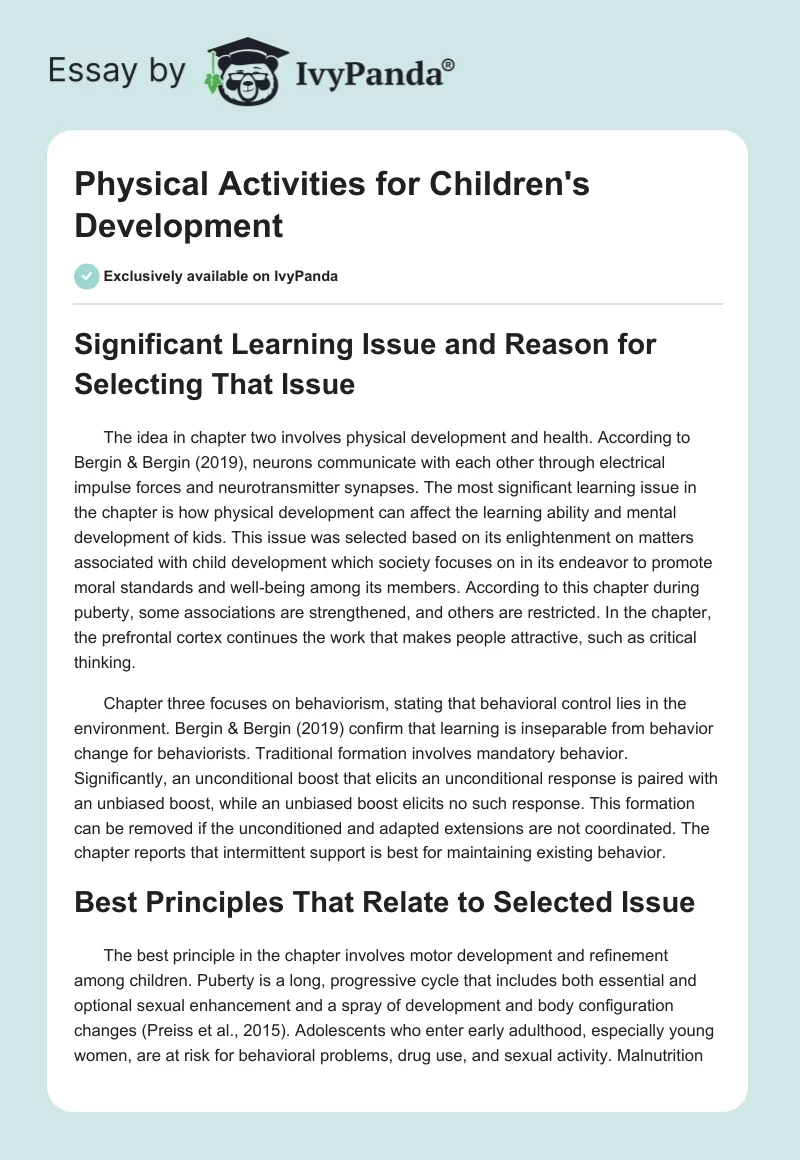Significant Learning Issue and Reason for Selecting That Issue
The idea in chapter two involves physical development and health. According to Bergin & Bergin (2019), neurons communicate with each other through electrical impulse forces and neurotransmitter synapses. The most significant learning issue in the chapter is how physical development can affect the learning ability and mental development of kids. This issue was selected based on its enlightenment on matters associated with child development which society focuses on in its endeavor to promote moral standards and well-being among its members. According to this chapter during puberty, some associations are strengthened, and others are restricted. In the chapter, the prefrontal cortex continues the work that makes people attractive, such as critical thinking.
Chapter three focuses on behaviorism, stating that behavioral control lies in the environment. Bergin & Bergin (2019) confirm that learning is inseparable from behavior change for behaviorists. Traditional formation involves mandatory behavior. Significantly, an unconditional boost that elicits an unconditional response is paired with an unbiased boost, while an unbiased boost elicits no such response. This formation can be removed if the unconditioned and adapted extensions are not coordinated. The chapter reports that intermittent support is best for maintaining existing behavior.
Best Principles That Relate to Selected Issue
The best principle in the chapter involves motor development and refinement among children. Puberty is a long, progressive cycle that includes both essential and optional sexual enhancement and a spray of development and body configuration changes (Preiss et al., 2015). Adolescents who enter early adulthood, especially young women, are at risk for behavioral problems, drug use, and sexual activity. Malnutrition causes developmental disabilities, delays puberty, and impairs mental health. Milk is the best food for newborns and is associated with advancing well-being and knowledge.
Similarly, chapter two presents Piaget’s mental reversal event theory. The chapter affirms that the central theme in Piaget’s hypothesis is that adolescents effectively construct information instead of latently duplicating what they see. Young people construct information by incorporating new data into existing mental designs or forcing those psychological designs to accommodate new data. Piaget assumed that development combined with experience leads to a reversal of events. Bergin & Bergin (2019) show that Piaget underestimated the intellectual abilities of young children and misjudged the abilities of adolescents and adults. Young children may not shy away from standard Piaget commands, such as failure to speak correctly, for reasons other than an inherent inability to be suspicious.
Relating the Key Ideas to Incidence in the Practice
I have noted over time that resting well allows one to do better in school and have higher academic achievement. Unfortunately, many teenagers, especially young adults, suffer from sleep deprivation. Body weight has been associated with low activity levels, excessive watching, poor eating habits, and parental behaviors such as unfriendly eating habits. McCormick & Scherer (2018) note that alcohol is the most commonly used drug, followed by tobacco and marijuana among youth. I have also experienced that heavy drug users usually start using in elementary school.
Chapter three relates how a learner’s skills are relational first and then intrapersonal. Culture determines what students know, how things are learned, and what tools are available for learning. Talking confidently is usually unhindered in younger children and then becomes introspective and calm, but even teens use flashy self-talk to tackle uncomfortable topics (Bergin & Bergin, 2019). Hence, a more powerful individual platform for student performance takes performance to a more meaningful level.
References
Bergin, C. C., & Bergin, D. A. (2019). Child&adolescent development in your classroom. Cengage Learning.
McCormick, C. B., & Scherer, D. G. (2018). Child and adolescent development for educators (2nd ed.). Guilford Publications.
Preiss, D. D., Calcagni, E., & Grau, V. (2015). Classroom research and child and adolescent development in South America.New Directions for Child and Adolescent Development, 2015(147), 85-92.


